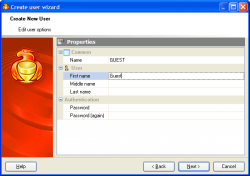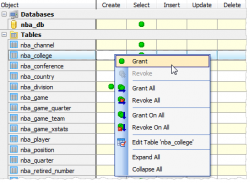Firebird Maestro: Product Tour
Users and Privileges
Firebird Maestro provides the easy-to-use graphical interface to manage Firebird server users and their privileges. Create User Wizard and Create Role Wizard guide you through the process of creating a new user or a new database role respectively. You can grant user privileges within the User Editor. At the same time the Role Editor is available to assign the role grants to a user. |

|

|
Firebird Maestro allows managing access privileges (Grants) for Firebird users and roles in the simplest way. Suppose the user John may have Insert privileges on the table Employee. Just open the User (John) Editor and set there the necessary grant. At the same time you can open the Table (Employee) Editor to specify the user permission. Consequently, when specific privileges for selecting, inserting, updating, deleting, referencing an object (e.g. table, procedure, view, etc.) are given, the object acquires the corresponding Permissions indicating which user or object was given a Grant. |
| Back | Next |



